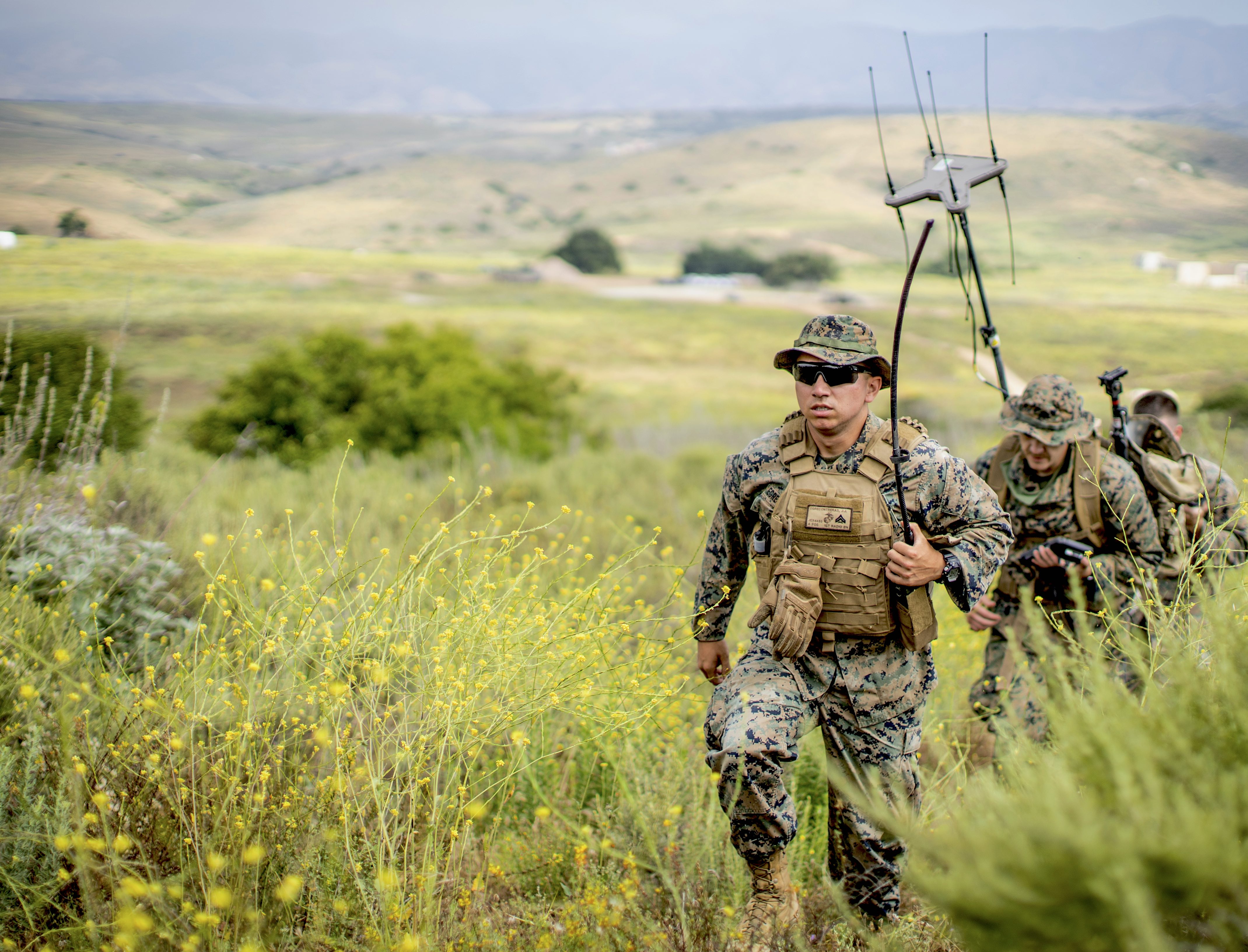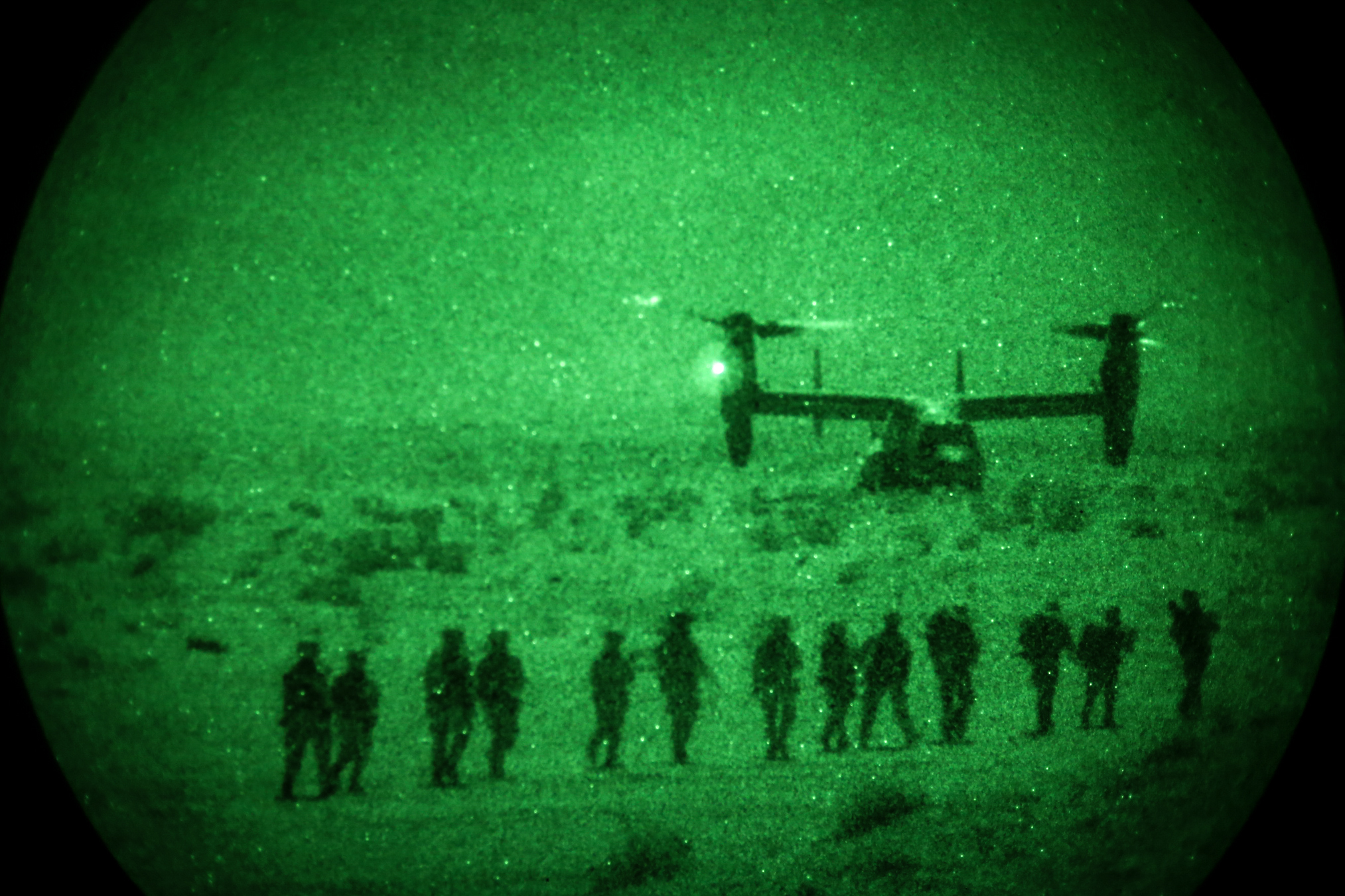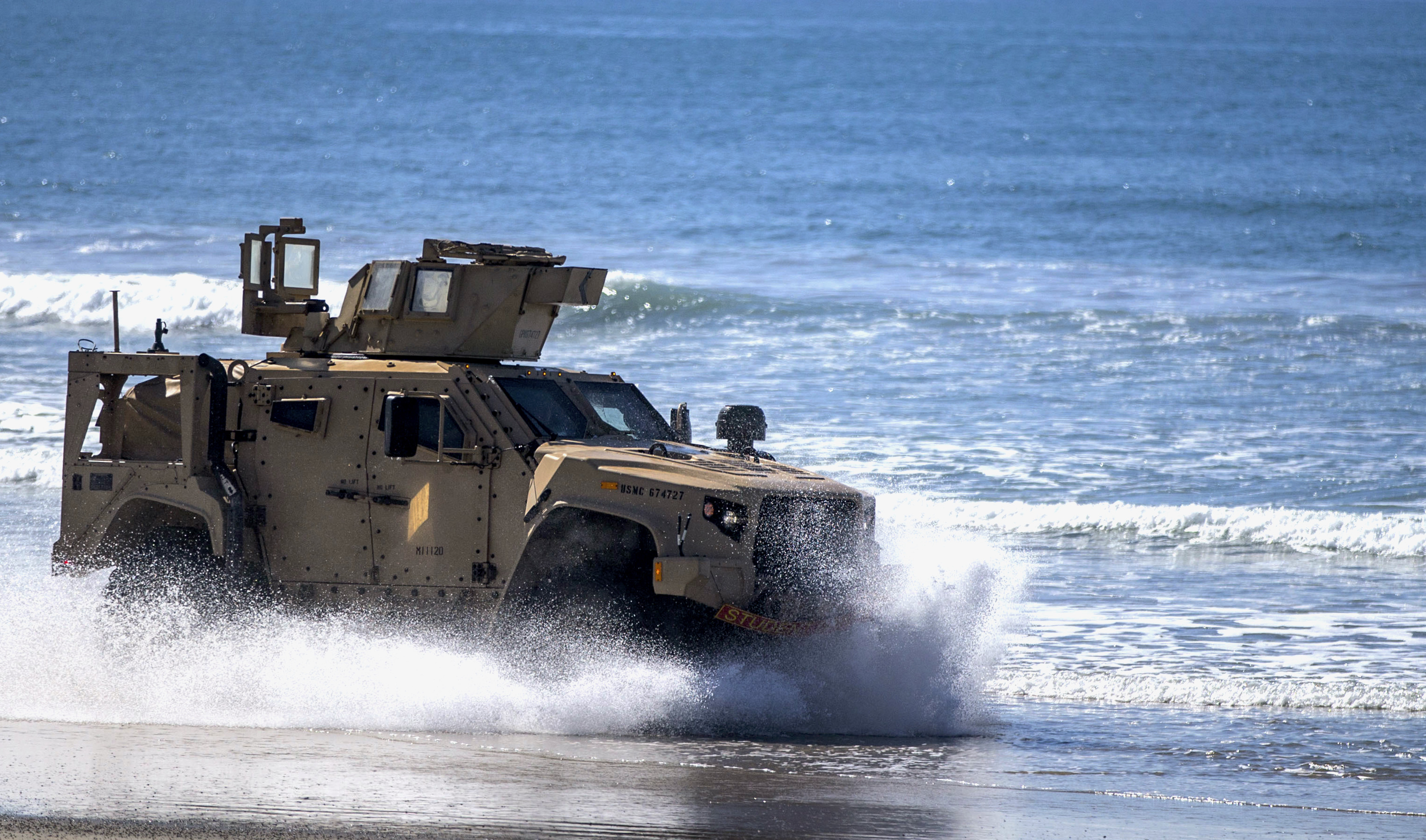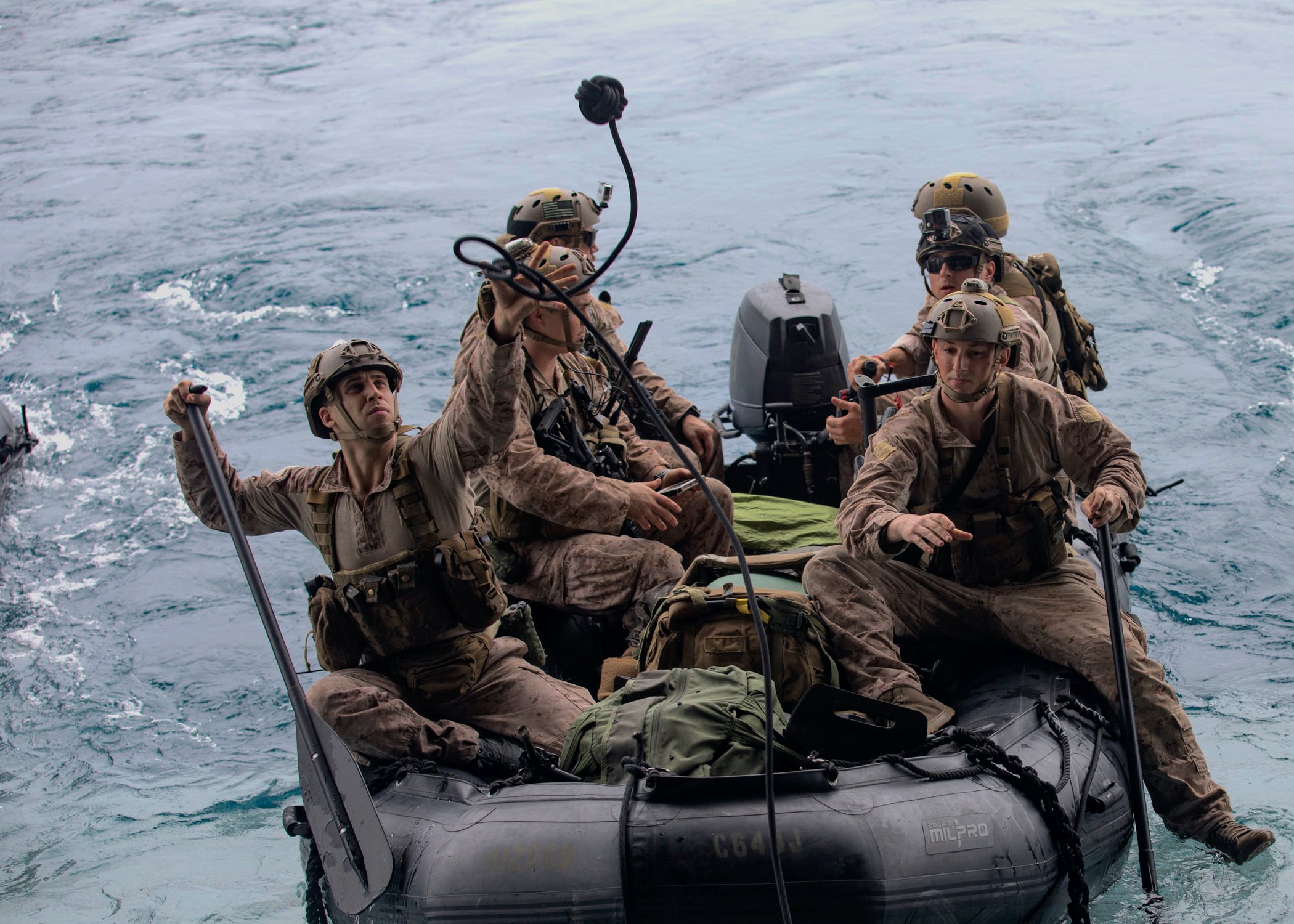
The Marine Corps is starting to form and experiment with the littoral regiment at the heart of its modern-day island-hopping strategy, the head of Marine Corps combat development told USNI News.
The stand-up of this first Marine Littoral Regiment is among the first and most visible steps being taken towards implementing the new Force Design 2030. The service will also test a ground-based anti-ship missile system in “weeks,” acquire stern landing vessels and a light amphibious warship to move smaller groups of Marines around the littorals in about three years, and transform the rest of the force by 2030 to reshape the Marine Corps for a fight against a peer adversary, Deputy Commandant for Combat Development and Integration Lt. Gen. Eric Smith told USNI News in a phone interview this week.
Service leadership is ready to take the plunge and go all in on this force transformation effort: Smith, formerly the commanding general of Japan-based III Marine Expeditionary Force, and Commandant Gen. David Berger, who previously held Smith’s job and prior to that led all Marines in the Pacific, have seen both the status quo of forces in the Pacific and the intelligence that shows where that force needs to evolve to. They spent months conducting modeling and simulation, wargames and table-top exercises ahead of releasing the Force Design 2030 in March. Both have acknowledged this will be an iterative process, but they’re ready to dive in and start the work of changing the Pacific-based Marines to be ready for the pacing threat the service sees in China.
“I am very confident that we have to reduce the size of the infantry battalion, I’m confident of that. Exactly how much, we gotta experiment with that. I say that because, for example, if you’re going to be light and lethal and able to operate in an austere environment, you have to be a little bit smaller and more powerful, you have to be, because if you’re still at the size we are now, I haven’t done anything to make myself more able to disaggregate underneath the watchful eye of a pacing threat,” Smith said in a phone interview this week.
“I’m very confident that we need more long-range precision fires. Exactly how much, we have a start point and we’ll adjust. We need more command and control. We need more ability to self-sustain, so that I don’t have to rely on big logistics ships or planes coming to help me out. How much? That’s what we’re determining.”
On the amphibious side of the service, the first step in the transformation will be changing the shape and structure of Marine Corps units. Existing and emerging technology will then be tacked on as they develop throughout the decade – things as small as improved radios and as large as a new fleet of light amphibious warships and supply ships to move Marines around the Pacific island chains. All the while, the service will continue to iterate to make sure it can pack a punch while also remaining stealthy and complicating an adversary’s ability to find and target them, Smith explained.
What is a Marine Littoral Regiment?

The idea of what a MLR would look like was actually generated by today’s colonels and lieutenant colonels who are leading infantry, artillery, aviation, logistics, intelligence and other units in the field. Smith said these leaders were assembled as an operational planning team and asked to consider what a future littoral fighting force might be, in light of the Littoral Operations in a Contested Environment (LOCE) and Expeditionary Advance Base Operations (EABO) concepts the Marines have developed.
“What would you make those look like? What would be needed? And they built a Marine Littoral Regiment on paper, and they wargamed it” against what intelligence suggests a peer threat would look like in 2030, Smith said.
The basic idea for the MLR is about 1,800 to 2,000 Marines and sailors – smaller than the 3,400-strong 3rd Marine Regiment operating out of Hawaii today – that would include three main elements: a Littoral Combat Team, a Littoral Anti-Air Battalion, and a Littoral Logistics Battalion, spokesman Maj. Josh Benson told USNI News.
“The Littoral Combat Team (LCT) is task-organized around an infantry battalion along with a long-range anti-ship missile battery. The LCT is designed to provide the basis for employing multiple platoon-reinforced-size expeditionary advance base (EAB) sites that can host and enable a variety of missions such as long-range anti-ship fires, forward arming and refueling of aircraft, intelligence, surveillance, and reconnaissance (ISR) of key maritime terrain, and air-defense and early warning,” he said.
“The Littoral Anti-Air Battalion is designed to train and employ air defense, air surveillance and early warning, air control, and forward rearming and refueling capabilities. The Littoral Logistics Battalion provides tactical logistics support to the MLR by resupplying expeditionary advance base sites, managing cache sites, and connecting to higher-level logistics providers,” along with also providing for medical and maintenance capabilities.
A regimental headquarters would supplement these organizations with “enhanced signals and human intelligence, reconnaissance, communications, logistics planning, civil affairs, cyber, and information operations capabilities.”
3rd Marine Regiment in Hawaii will be the first to transform to a Marine Littoral Regiment and will conduct the experimentation meant to refine that vision before converting the other two regiments, 4th and 12th Marine Regiments in Japan, Smith explained. Most of the Marines that will form the first MLR are already in Hawaii, though Benson said the anti-air battalion will be staffed by units not currently stationed in Hawaii.
Wargaming is still ongoing, Smith said, but live experiments will really help bring this vision to life. The Marine Corps Warfighting Lab helped develop an experimentation plan that has already been briefed to top generals, and ahead of each field exercise or experiment MCWL will give the regiment a series of goals and questions to answer.
For example, Smith said, they may go out with a communications detachment of a certain size and with certain radio and satellite communications capabilities, and be told to see how far they can go without losing connectivity, how long they can operate without being discovered by the adversary, and how much resupply they need during their operations. Once they come back with answers to those questions, the next experiment may include an adjusted communications detachment based on feedback.

“This is going to be iterative, back and forth. 3rd Marines will experiment with it, and they’re going to tell us through exercises, Pacific Blitz, their Pohakuloa Training Area exercises, out to Kahuku which is a northern training area, or Bellows Beach. That’s how we’re actually going to experiment, and we’re going to adjust it … until we get it just right,” Smith said.
“And as soon as we get it, quote, just right, the enemy is going to do something that’s going to cause it to change.”
Smith said the kickoff of experimentation has been delayed due to COVID-19-related travel restrictions. MCWL is located at Marine Corps Base Quantico in Virginia, and the service wants to embed MCWL representatives into the exercises to help monitor and collect information. Smith said the experiments would start as soon as they can get the right personnel in place, likely in the fall.
As the structure of the MLR comes into shape, they’ll be able to adapt to technology advances. For example, the Joint Light Tactical Vehicle (JLTV) is in production and fielding now, so while the regiment might not have the vehicles yet, they can safely assume that a certain capability is on its way. In other areas, the MLR is being developed to be platform-agnostic so they can use what’s on hand today and upgrade if new technology becomes available.
For long-range precision fires, for example, the Marine Corps has a vision of firing a Naval Strike Missile from a launcher on an unmanned JLTV for now, though in parallel research will also be devoted to an even longer-range missile.
“The beauty of the Naval Strike Missile is, it already exists. It’s what the Navy shoots now, it’s been fired for years. We have already done some testing of it, and we will continue doing testing of it literally within weeks,” Smith said. In a hearing in March, Smith said the service launched an inert round off a JLTV to prove the missile could launch in that manner, ahead of a June live-fire test.
“I’m pretty confident on the Naval Strike Missile, and that we will get range – we’ll always want more range, but we will get range off of that. And then again, I build a unit that can employ long-range fires against adversary targets that can move, which includes ships. So if a newer, better system comes along in seven, eight, nine years, five years, we can shoot that too; I’m agnostic about what I shoot.”
This littoral community transformation is just one piece of the overall Force Design 2030 effort – which also includes cutting tanks and bridging companies, reducing support such as heavy lift squadrons and artillery cannon batteries, and using some of those savings to invest in technologies like unmanned ground vehicles and aircraft.
Though the overall transformation of the Marine Corps will take until the 2030 deadline, Smith said, “within a couple three years we hope to get after the initial phases of this, so you can actually see some forward progress” on things like the Marine Littoral Regiment conversion and the small amphibious and logistics ships to support them.
Criticisms of the Plan

Smith said he’s confident in the plan that he, Berger and leaders up and down the chain of command have helped craft for the future of the Marine Corps, but that doesn’t mean they haven’t faced their share of criticism.
Chief among those voicing concern is Jim Webb, a former Navy secretary, senator and Marine officer, who wrote a National Interest essay suggesting the Marine Corps was too narrowly tailoring its future for a fight against China, at the expense of being prepared for other kinds of fights against other kinds of adversaries.
Smith told USNI News that even the three Pacific-based regiments, which would see the most change, would still be relevant in all geographies and for all operations. The effort to build an amphibious force that fleet commanders clamor for doesn’t take away from their role as a 911 fight-tonight force for all contingencies, he said.
“We’re building a force that can do expeditionary advance base operations. And those EABs against a pacing threat – small enough to be survivable, mobile, lethal – you can also pull them together in a less threatening environment, and they can kick the living you-know-what out of somebody because of their long-range fires, because of their ability to aggregate more securely,” the general said.
“We’re going after the pacing threat, and if we do that, we believe we can deal with the other threats that present themselves.”
Forces based in the continental U.S., who would be most likely to deploy to Europe or the Middle East, will see fewer changes in the Force Design – chiefly, they’ll be affected by the smaller infantry battalions the service wants. Smith offered that continuity as proof that, while Berger has been asking “what does the Navy need from me?”, the Marine Corps won’t be abandoning its other missions and skill sets.
“We’ve demonstrated what we can do for [U.S. Central Command] in Iraq and Afghanistan. We’ve demonstrated what we can do as part of the new normal in [U.S. Africa Command]. Now we have to demonstrate something we haven’t done in about 20 years because of the wars in Iraq and Afghanistan: demonstrate our utility to the fleet commander. It’s not either or; it’s both.”





